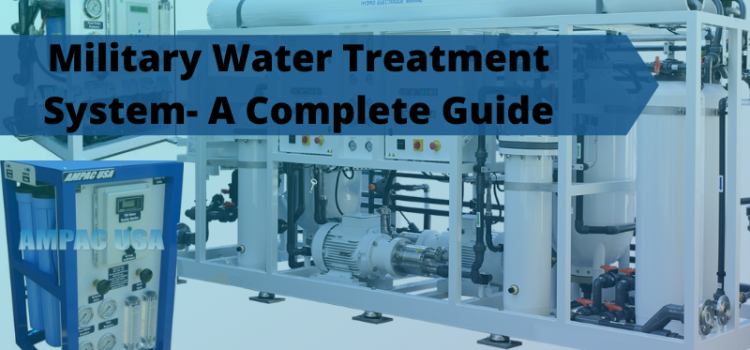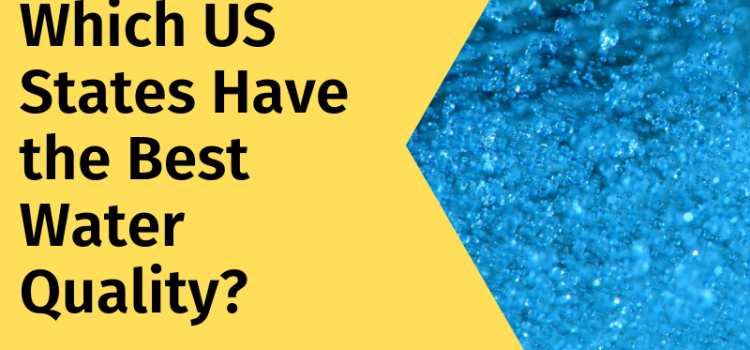Last updated on September 6th, 2025 at 03:32 pm
The military serves the nation and protects it from harm. It is vital to ensure that the military personnel remain healthy and access pure water in such a situation. All this leads to the need for a military water treatment system that can purify water from any source and ensure that military personnel get 100% contamination-free water. Here’s a complete guide by Ampac USA on military water treatment systems and where to buy one of these.
In challenging terrains and high-risk environments, clean water is a mission-critical resource for military operations. Whether deployed in arid deserts, dense jungles, or conflict zones with compromised infrastructure, armed forces depend on robust, reliable water purification systems to ensure the health and operational readiness of personnel. This guide delivers an in-depth analysis of military water treatment systems, their components, functionality, and the advantages they provide in both combat and disaster relief scenarios.
The Need for Military Water Treatment Systems
Military operations often unfold in regions with little to no access to potable water. Reliance on local sources without proper treatment could lead to waterborne illnesses, compromising the health and performance of troops. Military water purification units (WPUs) are engineered to process water from contaminated, saline, or otherwise unsafe sources—transforming it into clean, safe drinking water under demanding field conditions.
Key Components of a Military Water Treatment System
A high-performance military water treatment system integrates several advanced technologies to ensure multi-stage purification. Below are the key components:
- Pre-Filtration Units
These units remove suspended solids, dirt, and debris from water sources such as rivers, lakes, or swamps. Bag filters and multimedia filters are typically used for this primary filtration phase.
- Reverse Osmosis Modules
The heart of the system, reverse osmosis (RO) membranes, effectively eliminate:
- Dissolved salts
- Heavy metals
- Bacteria and viruses
- Pesticides and chemical pollutants
RO technology ensures that even brackish or seawater can be converted into potable water fit for human consumption.
- Activated Carbon Filters
These filters absorb organic contaminants, chlorine, and volatile compounds, improving both the taste and odor of the water.
- UV and Chemical Disinfection Units
Ultraviolet (UV) light is employed to inactivate pathogens, while chemical disinfectants like chlorine or iodine may be used to ensure water remains germ-free during storage and distribution.
- Pressure Boosters and Pumps
Designed to withstand harsh environments, military-grade pumps facilitate continuous water flow through various stages of treatment—even under fluctuating pressure conditions.
- Portable Storage Tanks
Collapsible and easily transportable, these tanks store the purified water, ready for use in camps, field hospitals, and mobile kitchens.
Types of Military Water Purification Systems
Military water treatment technologies vary in capacity, mobility, and application. Below are the most common types:
- ROWPU (Reverse Osmosis Water Purification Unit)
Widely deployed by the U.S. Army and NATO forces, ROWPU systems can purify water from any source—including nuclear, biological, or chemical (NBC) contaminated sites. These units range in capacity from 600 to 3,000 gallons per day (GPD) and are built into trailers or containers for rapid deployment.
- Mobile Water Purification Trailers
These self-contained systems are equipped with diesel generators, integrated RO units, and heavy-duty wheels for transportation across rugged terrain. They are ideal for forward operating bases and disaster response missions.
- Solar-Powered Water Treatment Units
Designed for silent operation in remote regions, solar-powered units use solar panels and battery backups to drive RO membranes and UV filters. They offer sustainable solutions where fuel supply is limited.
- Man-Portable Water Purifiers
Compact systems carried by individual soldiers or small units, these devices are capable of treating water on-the-go, using manual pumps, chemical tablets, or compact RO membranes.
Military Applications of Water Treatment Systems
- Field Deployment
Military water systems ensure that troops have access to safe drinking water during extended missions in remote or hostile regions.
- Disaster Relief and Humanitarian Aid
Armed forces are often first responders during natural disasters. Military-grade water purifiers are crucial in supplying clean water to affected populations and setting up emergency field hospitals.
- Mobile Field Hospitals
To prevent cross-contamination and infection, field hospitals must rely on sterile water. Military systems provide continuous, purified water for medical procedures and hygiene.
- Amphibious and Naval Operations
Naval forces and marines require Seawater desalination systems onboard ships and landing crafts to convert seawater into fresh water.
Benefits of Military Water Treatment Systems
- Rugged Design
Built to withstand extreme temperatures, dust, shock, and vibrations, military systems ensure uninterrupted operation in the harshest environments.
- Rapid Deployment
Compact, modular, and often containerized, these systems can be rapidly transported by air, sea, or land—enabling swift water setup in critical areas.
- Multi-Contaminant Protection
Unlike civilian systems, military water purifiers are designed to handle a broad spectrum of contaminants, including radiological and chemical agents.
- Scalable Capacity
From individual purification bottles to large-scale ROWPUs, the system can be scaled based on mission requirements.
- Automated Operation
Modern systems come equipped with touchscreen panels, remote monitoring, and automated backwash cycles, reducing the need for technical oversight.
Standards and Regulations
All military water treatment systems are developed in compliance with NSF/ANSI standards and are subjected to rigorous testing under Department of Defense (DoD) specifications. Common benchmarks include:
- TB MED 577: Standards for potable water in field operations
- MIL-STD-810: Environmental engineering considerations
- NATO STANAGs: Standard agreements for interoperability among allied forces
Emerging Technologies in Military Water Treatment
- AI-Driven Water Quality Monitoring
Integrated sensors and AI algorithms monitor water quality in real-time, allowing for predictive maintenance and contamination alerts.
- Graphene-Based Filtration
Graphene membranes offer superior filtration efficiency and durability, and are being tested in next-generation portable systems.
- Atmospheric Water Generators (AWG)
These systems extract water from ambient humidity—a revolutionary solution for arid regions where traditional water sources are unavailable.
Top Manufacturers of Military Water Treatment Systems
Leading global manufacturers providing military-grade water purification solutions include:
- AMPAC USA – Specializes in advanced mobile reverse osmosis systems for military and disaster relief
Deployment and Maintenance Considerations
To ensure optimal performance, military water purification systems require regular:
- Filter and membrane replacement
- Sanitization protocols
- System diagnostics and calibration
- Operator training
Comprehensive training programs are critical, enabling military personnel to operate, troubleshoot, and maintain the systems even under duress.
Conclusion
Military water treatment systems are not just logistical necessities—they are strategic assets. Their ability to transform hostile water sources into safe, drinkable resources strengthens operational endurance, protects personnel health, and expands mission capabilities. From tactical field units to large-scale humanitarian deployments, investing in high-quality military purification solutions ensures success in both combat and crisis.
FAQs – Military Water Treatment System: A Complete Guide by Ampac USA
Q1. What is a military water treatment system?
A military water treatment system is a specialized unit designed to purify and disinfect water from lakes, rivers, wells, seawater, or contaminated sources, making it safe for soldiers and personnel to drink in remote or combat zones.
Q2. Why are military water treatment systems important?
They ensure a continuous supply of safe drinking water for troops, preventing dehydration, waterborne diseases, and logistical challenges of transporting bottled water to remote locations.
Q3. How do military water treatment systems work?
Most systems use multi-stage purification methods such as sediment filtration, activated carbon, Reverse Osmosis (RO), and UV sterilization to remove dirt, chemicals, salts, and harmful microorganisms.
Q4. Can Ampac USA’s military systems handle seawater purification?
Yes. Ampac USA designs seawater desalination units capable of producing fresh, potable water from seawater sources, making them ideal for naval operations and coastal deployments.
Q5. What makes Ampac USA’s military water treatment systems unique?
They are rugged, portable, and engineered to perform under extreme conditions. Features include quick setup, high output capacity, reliability, and minimal maintenance—tailored for defense and emergency use.
Q6. How portable are these systems?
Ampac USA offers systems in containerized, skid-mounted, and mobile configurations, ensuring easy transportation and quick deployment in the field.
Q7. What is the typical water production capacity?
Depending on the model, production ranges from a few hundred gallons per day (for small units) to thousands of gallons per day (for large field operations).
Q8. Do these systems meet military and international water standards?
Yes. Ampac USA’s systems are built to meet or exceed U.S. Military, WHO, and EPA drinking water standards, ensuring safe and reliable water at all times.
Q9. Can they be used in disaster relief and humanitarian missions?
Absolutely. While designed for the military, these systems are equally valuable for disaster response, refugee camps, NGOs, and emergency preparedness.
Q10. What maintenance is required for military water treatment systems?
Routine filter replacement, periodic cleaning, and inspection of pumps and membranes are usually sufficient. Ampac USA provides training and support for easy operation and upkeep.
Q11. How long do these systems last?
With proper maintenance, Ampac USA’s military water treatment systems can last for many years, even under demanding operational environments.
Q12. How can organizations purchase or request a custom-built unit?
Interested buyers can contact Ampac USA directly for consultation, customization, and purchase options tailored to specific military or field requirements.










Can you be more specific about the content of your article? After reading it, I still have some doubts. Hope you can help me.